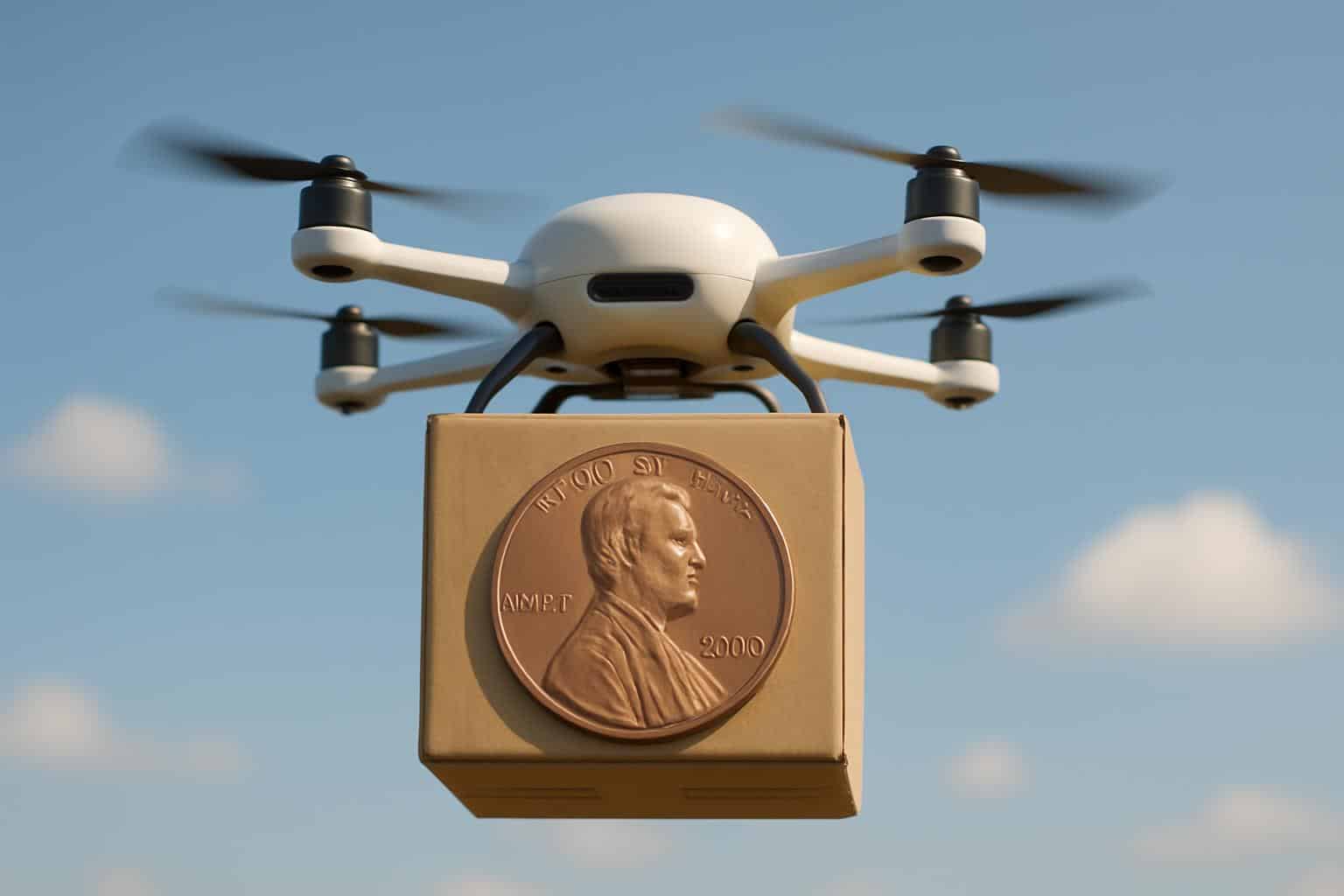Indian startup Airbound has raised $8.65 million in seed funding to develop ultra-light, rocket-shaped drones capable of delivering packages for as little as one cent. The round was led by Physical Intelligence co-founder Lachy Groom, along with support from Humba Ventures, existing investor Lightspeed Venture Partners, and senior leadership from Tesla, SpaceX, and Anduril. As the company races to validate costs at scale, it is kicking off a medical logistics pilot with Narayana Health in Bengaluru.
A Rocket-Like Tail-Sitter Custom-Made for Efficiency
Airbound’s flying machine is a departure from the typical quadcopter design that dominates the industry. It employs a tail-sitter configuration that takes off vertically, accelerates to high speed, then transitions to wing-borne lift, combined with a fuselage featuring an even more expansive blended wing-body planform than those considered for the X-48, and uses only two propellers. The carbon-fiber airframe is designed to keep hover time low and lift-to-drag high in cruise, a combination that promises significant reduction in energy burned per kilometer.

The original model weighs about 3.3 pounds and can carry a payload of up to 2.2 pounds, a high mass-to-payload ratio for VTOL drones. Airbound’s next model, it says, is designed to carry 6.6 pounds, while the airframe will weigh just over 2.6 pounds. The company states the goal bluntly: deploy aerodynamic efficiency and extreme weight reduction to bring operating costs down by an order of magnitude — or more — relative to traditional multicopters.
The project was founded by Naman Pushp, who at the time was a teenager, in 2020 as he iterated from taped foam mockups to composite prototypes during lockdown. Now at the head of a 50-person team, Pushp says that last-mile autonomy is, fundamentally, a question of physics and manufacturing: the lower mass, higher efficiency, and fewer moving parts you’ve got, the more both energy costs and maintenance scale down.
Cost Stack and the One-Cent Delivery Promise
Airbound estimates the internal cost per drone is around $2,000 and its current pilot delivery cost is approximately ₹24, or 27 cents. The roadmap aims to achieve sub-₹5 per drop by the end of 2026, then ultimately broad-scale deliveries at one cent. To achieve that, the company is relying on parts with a longer service life and an efficient, automated way of operating.
One of the most significant choices is in battery chemistry. Instead of lithium-polymer packs that are common in both hobby and commercial drones, Airbound is built around lithium-ion cells, which tend to offer several times better cycle life at reduced maintenance frequencies. Battery degradation is a hidden driver of per-drop cost; it matters more to spread it out over thousands of flights than to save an extra couple of minutes in recharge time.
The scale of the ambition is notable in this context. McKinsey & Company analysts peg last-mile at 40 to 50 percent of the total logistics bill in e-commerce, and today’s supplier last-mile drone drops have historically cost single-digit dollars a delivery, depending on geography and volume. To attain economics at the cents-per-seat-mile level, high route density and near-zero-touch ground handling would be necessary — along with a high degree of autonomy and little airframe fatigue per flight.

Airbound expects to ramp production up from one drone per day in Bengaluru to more than 100 a day, with the capacity for more than a million deliveries per day by the middle of 2027. That production target is intertwined with the company’s cost thesis — standardized airframes, reusable modules, and predictive maintenance to maximize utilization.
Regulatory Path and Medical Pilot Plans in India
The company has started a three-month pilot with Narayana Health, sending blood samples, lab tests, and critical medical supplies around Bengaluru, with aims of roughly 10 deliveries per day in the early going. Medical logistics is a well-worn test bed for drone networks because its payloads are small, time-sensitive, and high-value, setting a clear bar for safety and reliability.
Airbound said it was working with India’s Directorate General of Civil Aviation on approvals. The Drone Rules in India and the Digital Sky platform have facilitated beyond-visual-line-of-sight trials, along with targeted projects like the production-linked incentive scheme for drones to localize supply chains. That being said, scaled routine BVLOS operations will still need tested detect-and-avoid functionality, reliable communications, and connection to emerging unmanned traffic management (UTM) systems.
Competition and the Engineering Reality of Tail-Sitters
Airbound’s tail-sitter blended-wing strategy sets it apart from players such as Wing and Matternet that use multicopters and hybrid tilt systems, and Zipline’s most recent platform that combines a fixed-wing aircraft with a separate delivery droid. Tail-sitters like the WingtraOne model have shown great efficiency in mapping and surveying; however, deploying that design for high-frequency delivery introduces new challenges, including the ability to quickly turn around aircraft after a recharge, resilience to crosswinds, and the ability to land vertically with accuracy near people and amid buildings.
The engineering challenges go beyond just airframes. The economics of the network rely on automated loading, secure handoff at the curb or on rooftops, reliable battery health monitoring, and weather tolerance to maintain high completion rates. Insurers and regulators will judge safety cases and incident rates closely; future expansion to the U.S. would involve clearing FAA type certification, as well as BVLOS approvals that a relative handful of companies have so far secured.
What to Watch Next for Airbound’s Drone Program
In the short term, look for Airbound’s second-generation prototype to take flight next year, with production aimed at 2027. Proof points will include cents-per-drop trajectories in medical logistics and constant increases in daily sorties per aircraft, as well as toughness data over hundreds of charge cycles. If Airbound can deliver its tail-sitter efficiency by automating a fleet and maintaining regulatory momentum, it won’t just be marginal cost — it will be cent-cost delivery, from headline to measurable unit economics.

